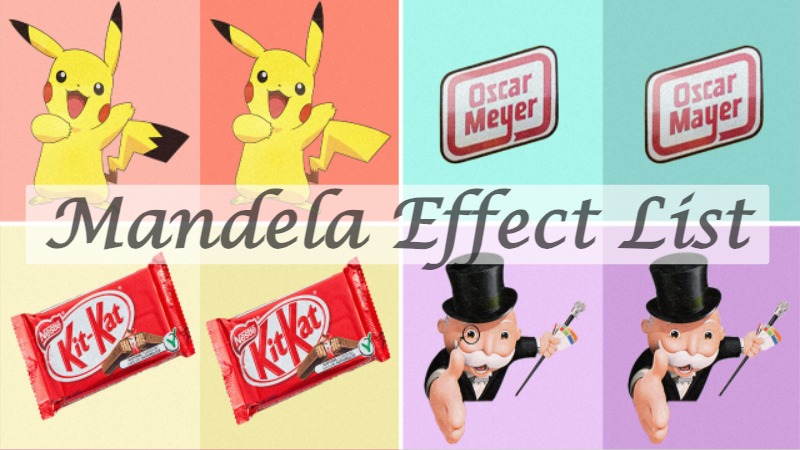
Mandela Effect refers to a phenomenon where a large group of people remember an event, fact, or detail one way, but it turns out to be different from their collective memory. The term was coined by Fiona Broome in 2010 after she discovered that she and many others believed Nelson Mandela had died in prison during the 1980s, even though he was released in 1990 and became the President of South Africa. Check Mandela Effect List with 55 examples that are surely mind blowing.
The Mandela Effect gained popularity through online discussions and social media platforms, where people started sharing instances where they collectively remembered something incorrectly. These instances often involve pop culture references, brand names, historical events, quotes from movies or books, and more. Here is a list of some commonly cited examples of the Mandela Effects.
Mandela Effect List with Examples
- Barbie’s Last Name: Many people think Barbie’s last name is “Barbie,” but her full name is actually Barbara Millicent Roberts.
- Berenstain Bears: Some remember the children’s book series as the “Berenstein Bears” instead of the correct spelling, “Berenstain Bears.”
- Billy Graham’s Death: Some people remember the evangelist Billy Graham dying years before his actual death in 2018.
- Braveheart: The title of the movie is often misremembered as “Braveheart,” referring to William Wallace, but the actual “Braveheart” was Robert the Bruce.
- C-3PO’s Leg: Some remember the Star Wars character C-3PO having a silver leg, when in reality, both of his legs are gold.
- Captain Crunch vs. Cap’n Crunch: Some remember the cereal brand as “Captain Crunch,” while it’s actually “Cap’n Crunch.”
- Cheese-It vs. Cheez-It: Some people remember the snack as “Cheese-It,” while others recall it as “Cheez-It.”
- Chick-fil-A vs. Chik-fil-A: Along with the previous example, some people remember the fast-food chain as “Chik-fil-A.”
- Color of Chartreuse: Some people remember chartreuse as a shade of pink or red, when it’s actually a yellow-green color.
- Color of Uncle Sam’s Hat: Some people recall Uncle Sam’s iconic hat being red and white striped, but it’s actually red, white, and blue.
- Cup Noodles vs. Cup O’ Noodles: The instant noodle brand is actually “Cup Noodles,” but some remember it as “Cup O’ Noodles.”
- Curious George’s Tail: Many recall Curious George, the fictional monkey, having a tail, when in fact he doesn’t have one.
- Dolly’s Braces in Moonraker: Many remember the character Dolly having braces in the James Bond film “Moonraker,” but she never had them in the movie.
- Febreze vs. Febreeze: Some recall the household product as “Febreeze,” but it’s actually spelled “Febreze.”
- Field of Dreams Quote: The famous line “If you build it, they will come” from the movie “Field of Dreams” is often misquoted as “If you build it, he will come.”
- Forrest Gump Quote: The line “Life is like a box of chocolates” from the movie “Forrest Gump” is often misquoted as “Life was like a box of chocolates.”
- Fruit of the Loom Logo: People often remember the cornucopia (horn of plenty) being part of the Fruit of the Loom logo, but it never actually existed in the company’s logo.
- Henry VIII’s Turkey Leg: Many people associate King Henry VIII with holding a turkey leg in portraits, even though there’s no historical evidence of this.
- Interview with A Vampire vs. Interview with The Vampire: Some recall the title of the vampire-themed movie as “Interview with A Vampire,” but the correct title is “Interview with The Vampire.”
- JCPenney vs. JC Penney: The department store’s name is “JCPenney,” but some remember it as “JC Penney.”
- JFK Assassination: Some people remember there being four people in the car during the JFK assassination, when there were actually six people.
- Jif Peanut Butter: Some remember the peanut butter brand as “Jiffy” or “Jiff,” but it’s actually “Jif.”
- Kit-Kat vs. KitKat: Some remember the chocolate bar as “Kit-Kat,” with a hyphen, when it’s actually “KitKat.”
- Lindbergh Baby’s Fate: Some believe that the Lindbergh baby, kidnapped in 1932, was found safe and returned, when in reality, the baby was tragically murdered.
- Lion and the Lamb: Many people recall the biblical phrase as “The lion shall lay down with the lamb,” but the correct version is “The wolf shall dwell with the lamb.”
- Loch Ness Monster Photo: The famous photograph of the Loch Ness Monster is often remembered as more clear and detailed than it actually is.
- Looney Toons vs. Looney Tunes: Some remember the cartoon series as “Looney Toons,” but it’s actually “Looney Tunes.”
- Luke, I am your father: Often misquoted from Star Wars, the actual line is “No, I am your father.”
- Mars and Moon Colors: Some people remember Mars being a brighter red and the Moon having a bluish tint when observed from Earth.
- Mickey Mouse’s Braces: Some recall Mickey Mouse having braces on his teeth, but he never actually had them in any official Disney artwork.
- Mirror Image Decals on Cars: Some remember the “Objects in mirror are closer than they appear” text on car mirrors as being a mirror image, but it’s actually correctly oriented.
- Mona Lisa’s Expression: Some remember the Mona Lisa’s expression as having a clear smile, while others perceive it as more neutral.
- Mr. Monopoly’s Monocle: Similar to the Monopoly Man, some people believe that Mr. Monopoly (the character on the Chance and Community Chest cards) wears a monocle, but he doesn’t.
- Nelson Mandela’s Death: Many people remember Nelson Mandela dying in prison during the 1980s, but he was actually released in 1990 and passed away on December 5, 2013.
- New Zealand’s Location: Some people believe that New Zealand is located northeast of Australia, while it’s actually southeast.
- Number of US States: Some people remember there being 51 or 52 states in the United States, when there are actually 50 states.
- Oscar Mayer vs. Oscar Meyer: The brand of processed meats is actually “Oscar Mayer,” but some remember it as “Oscar Meyer.”
- Oscar Statuette Pose: Many remember the Oscar statuette holding a sword, but it doesn’t actually have one.
- Pikachu’s Tail: Many recall the Pokémon character Pikachu having a black-tipped tail, but his tail is actually completely yellow.
- Queen in Snow White: Many remember the Evil Queen in Snow White saying, “Mirror, mirror on the wall,” when she actually says, “Magic mirror on the wall.”
- Queen Song “We Will Rock You”: Some people remember the chorus of the song starting with “We will, we will rock you,” when it actually starts with “Buddy, you’re a boy, make a big noise.”
- Reebok Logo: Some remember the Reebok logo as having a horizontal line connecting the “R” and the rest of the letters, when in fact there’s no line.
- Sex in the City vs. Sex and the City: Some remember the TV series as “Sex in the City,” but the correct title is “Sex and the City.”
- Shazam Movie: Some recall a movie called “Shazam” starring comedian Sinbad as a genie, but no such movie exists. This is often confused with the movie “Kazaam” starring Shaquille O’Neal.
- Skechers vs. Sketchers: The shoe brand is actually spelled “Skechers,” but many remember it as “Sketchers.”
- Starbucks Logo Siren: Some people remember the Starbucks logo featuring the siren with a more revealing appearance, but the current logo is more modest.
- Stouffer’s vs. Stouffers: Some remember the frozen food brand as “Stouffer’s,” while others recall it as “Stouffers.”
- The Apollo 13 Quote: The line “Houston, we have a problem” from the Apollo 13 mission is often misquoted as “Houston, we’ve had a problem.”
- The Flintstones vs. The Flinstones: Some remember the animated TV show as “The Flintstones,” while others recall it as “The Flinstones.”
- The Monopoly Man’s Name: Some people mistakenly believe that the Monopoly Man’s name is “Rich Uncle Pennybags,” when in fact, he doesn’t have an official name.
- The Smokey Bear vs. Smokey the Bear: Some remember the forest fire prevention character’s name as “Smokey the Bear,” when the correct name is “Smokey Bear.”
- The Statue of Liberty’s Position: Many remember the Statue of Liberty being on Ellis Island, but it’s actually located on Liberty Island.
- The Thinker Statue: Some recall the iconic statue “The Thinker” by Auguste Rodin as having his fist against his forehead, when he actually has his hand against his chin.
- ThunderCats’ Battle Cries: Some people remember Lion-O’s battle cry as “ThunderCats, ho!” when it’s actually “ThunderCats, ho!” and Panthro’s as “Thunder, thunder, thunder, ThunderCats, ho!” when it’s actually “Thunder, thunder, thunder, ThunderCats, ho!”
- Ugly Duckling Story: Many people remember “The Ugly Duckling” story as being about a duck that transforms into a swan, but the original story is about a cygnet (young swan) that is mistaken for an ugly duckling.
Why Mandela Effect Happens?
The Mandela Effect has led to various theories and discussions about the nature of memory, human perception, alternate realities, and the influence of cultural factors on our recollection of events. It is generally attributed to flaws in human memory, such as the brain’s tendency to fill in gaps with familiar information or the influence of repeated exposure to certain information, rather than evidence of alternate realities or parallel universes.
Many of the discrepancies as mentioned in Mandella Effect list can be attributed to false memory, the way our brains store and retrieve information, and the influence of popular culture. The phenomenon has sparked discussions about memory, perception, and the malleability of human recollection. This effect is often a result of collective misremembering and the human brain’s tendency to fill in gaps in memory with familiar or expected information. It’s a fascinating phenomenon that sheds light on the complexities of human perception and memory.










